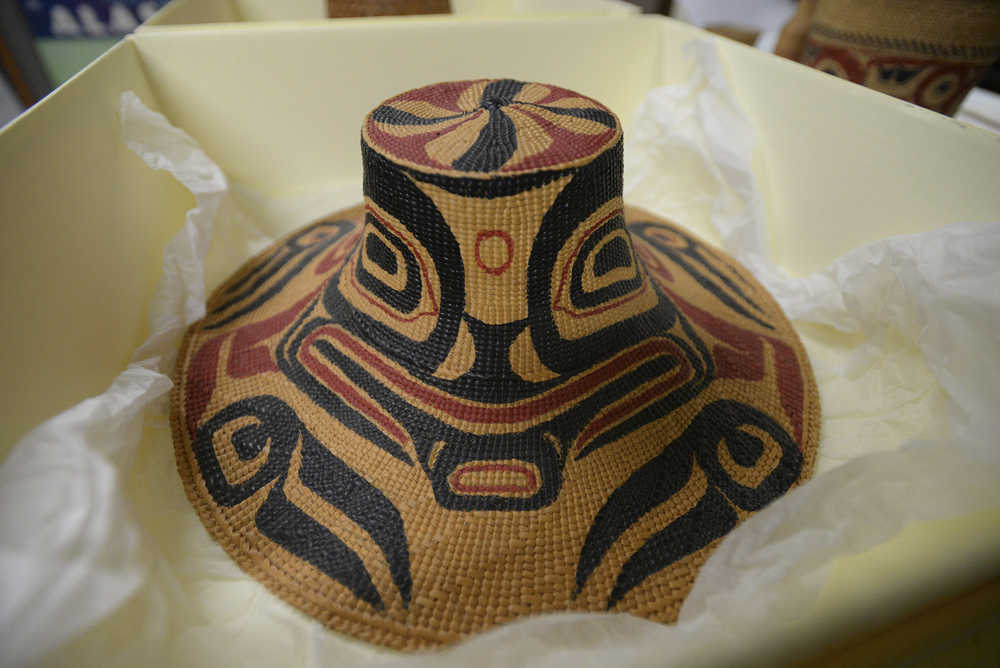KETCHIKAN — When Peter Corey, former curator of the Alaska State Museum and the Sheldon Jackson Museum, died Sept. 20 in Sitka, he left behind a massive collection of Alaska Native art. Now, some of the pieces have found their way home to Ketchikan.
The Tongass Historical Museum, in November, received six pieces from Corey’s collection. The pieces — three baskets, a bottle cover, a painted hat and a cedar bark cover hat — were made in the 1970s by local Haida weaver Selina Peratrovich, with painting done by Ketchikan artist Nathan Jackson, according to museum director Lacey Simpson and Hayley Chambers, the museum’s senior curator of collections.
“He was a big, big collector,” Chambers said about Corey. “And his home — I can only kind of imagine what it looked like, I’ve heard stories, I used to live in Sitka and I’d walk by and kind of see it — but it was packed full of stuff. They have been going through and processing things in his house and sending items to the appropriate places that he designated, but it sounded like he had thousands of things. Baskets inside of baskets inside of baskets.”
Corey — who also was involved with the installation of totem poles at the Totem Heritage Center — kept his collection in good shape, including maintaining diligent records on many items.
“They could use a little bit of cleaning, but otherwise they’re in amazing condition,” Chambers said. “Just a little bit of dust on one of the hats, but it almost seemed like Peter got the items and then he put them on display or in a case of some kind, and he had them protected right away.”
On one of the baskets — made specially as a Christmas gift for Corey — Peratrovich weaved Corey’s initials into the basket.
Of the pieces the museum received, the cover hat is a bit less likely to be found in exhibits.
“There usually aren’t any in museum collections,” Chambers said. “I’ve been talking with some folks at the Anchorage museum to better understand their purpose, or why they might have gone out of use, and it sounds like … it might have been an issue of the painted one being a little more exciting for people that are buying them, and they don’t know that the cover hat served a purpose — to protect the painted one.”
Simpson added that the painted hat, if it were worn, would have been for ceremonial use.
“You wouldn’t go for a hike with those,” she said.
The woven bottle cover also attracted the interest of the museum.
“Covering bottles with basketry has been sort of a curio tradition for a really long time,” Simpson said. “Once manufactured glass bottles started to make their way into the northwest coast, it was a great — kind of ready-made — form. They really appealed to visitors and tourists.”
“It was kind of a way for the Native traditions to adapt to modern uses,” Chambers added.
Holly Churchill, Peratrovich’s granddaughter and a weaver herself, said in a phone interview that she’s excited the pieces are coming back to Ketchikan.
“I’m equally excited that Peter Corey had them,” Churchill said. “He was a longtime friend. My grandmother gave him a Haida name before the heritage center was created. I’m excited that (the art is) coming to the museum.”
Corey and Peratrovich also worked together to help teach weaving arts — which were in danger of being lost — to younger generations, according to Churchill.
“My family’s just delighted that Peter had a love for the art,” Churchill said. “He could see the importance of developing a program (to teach the arts), and I think that it’s helped people build their self-esteem and be proud of their background.”
While there aren’t yet plans to permanently display the artwork, Simpson and Chambers are looking at potential times and locations to do so.

